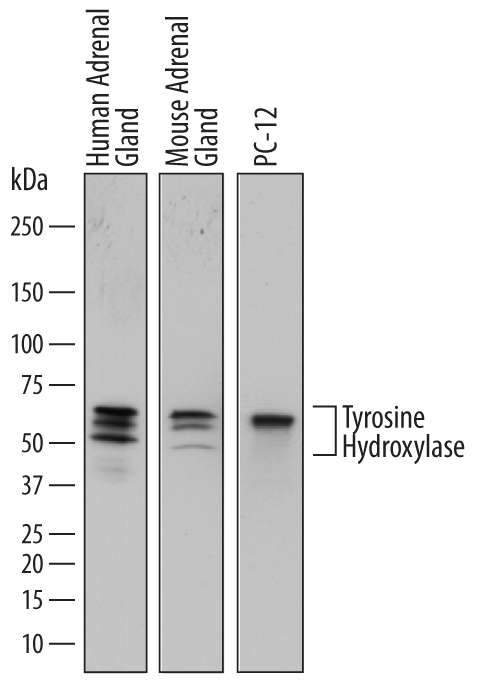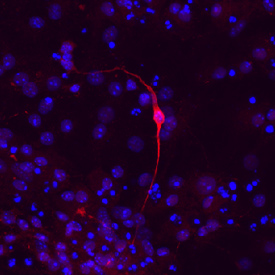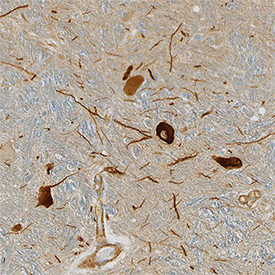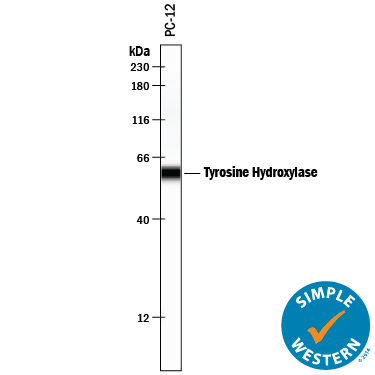Human/Mouse/Rat Tyrosine Hydroxylase Antibody Summary
Ala278-Tyr401, predicted
Accession # P07101
Applications
Please Note: Optimal dilutions should be determined by each laboratory for each application. General Protocols are available in the Technical Information section on our website.
Scientific Data
 View Larger
View Larger
Detection of Human, Mouse, and Rat Tyrosine Hydroxylase by Western Blot. Western blot shows lysates of human adrenal gland tissue, mouse adrenal gland tissue, and PC-12 rat adrenal pheochromocytoma cell line. PVDF membrane was probed with 1 µg/mL of Sheep Anti-Human Tyrosine Hydroxylase Antigen Affinity-purified Polyclonal Antibody (Catalog # AF7566) followed by HRP-conjugated Anti-Sheep IgG Secondary Antibody (Catalog # HAF016). Specific bands were detected for Tyrosine Hydroxylase at approximately 56-60 kDa (as indicated). This experiment was conducted under reducing conditions and using Immunoblot Buffer Group 1.
 View Larger
View Larger
Tyrosine Hydroxylase in D3 Mouse Embryonic Stem Cells. Tyrosine Hydroxylase was detected in immersion fixed D3 mouse embryonic stem cells using Sheep Anti-Human Tyrosine Hydroxylase Antigen Affinity-purified Polyclonal Antibody (Catalog # AF7566) at 10 µg/mL for 3 hours at room temperature. Cells were differentiated into dopaminergic neurons using R&D Systems Human/Mouse Dopaminergic Neuron Differentiation Kit (SC001B). Cells were stained using the NorthernLights™ 557-conjugated Anti-Sheep IgG Secondary Antibody (red; NL010) and counterstained with DAPI (blue). Specific staining was localized to dopaminergic neurons. View our protocol for Fluorescent ICC Staining of Cells on Coverslips.
 View Larger
View Larger
Tyrosine Hydroxylase in Human Brain (Medulla). Tyrosine Hydroxylase was detected in immersion fixed paraffin-embedded sections of human brain (medulla) using Sheep Anti-Human/Mouse/Rat Tyrosine Hydroxylase Antigen Affinity-purified Polyclonal Antibody (Catalog # AF7566) at 15 µg/mL for 1 hour at room temperature followed by incubation with the Anti-Sheep IgG VisUCyte™ HRP Polymer Antibody (VC006). Before incubation with the primary antibody, tissue was subjected to heat-induced epitope retrieval using Antigen Retrieval Reagent-Basic (CTS013). Tissue was stained using DAB (brown) and counterstained with hematoxylin (blue). Specific staining was localized to cytoplasm in neurons. Staining was performed using our protocol for IHC Staining with VisUCyte HRP Polymer Detection Reagents.
 View Larger
View Larger
Detection of Rat Tyrosine Hydroxylase by Simple WesternTM. Simple Western lane view shows lysates of PC-12 rat adrenal pheochromocytoma cell line, loaded at 0.2 mg/mL. A specific band was detected for Tyrosine Hydroxylase at approximately 59 kDa (as indicated) using 10 µg/mL of Sheep Anti-Human/Mouse/Rat Tyrosine Hydroxylase Antigen Affinity-purified Polyclonal Antibody (Catalog # AF7566) followed by 1:50 dilution of HRP-conjugated Anti-Sheep IgG Secondary Antibody (HAF016). This experiment was conducted under reducing conditions and using the 12-230 kDa separation system.
Reconstitution Calculator
Preparation and Storage
- 12 months from date of receipt, -20 to -70 °C as supplied.
- 1 month, 2 to 8 °C under sterile conditions after reconstitution.
- 6 months, -20 to -70 °C under sterile conditions after reconstitution.
Background: Tyrosine Hydroxylase
TH (Tyrosine 3-hydroxylase; also tyrosine 3-monooxygenase) is a 60-62 kDa member of the biopterin-dependent aromatic amino acid hydroxylase family of molecules. It is expressed by neurons of the dopamine and autonomic nervous system, plus the neuroendocrine cells of the adrenal medulla. TH is considered the rate limiting enzyme for catecholamine synthesis, and serves to catalyze the hydroxylation of L-tyrosine. It maintains stores of catecholamines following secretion, and its activity is regulated by targeted site phosphorylation. Human TH is 528 amino acids (aa) in length. It contains an N-terminal ACT domain (aa 69-190) that binds small molecules and regulates enzyme activity, and a C-terminal enzymatic region (aa 196-493). There are three significant utilized phosphorylation sites. Two at Ser31 and Ser40 increase enzyme activity, while phosphorylation at Ser19 promotes subsequent Ser40 phosphorylation. TH functions as a 240 kDa noncovalent homotetramer. There are four potential splice variants. One shows a deletion of aa 31-34, a second shows a deletion of aa 31-61, while a third contains a Met substitution for aa 1-34. A fourth isoform variant shows a deletion of aa 35-61. Over aa 278-401, human TH shares 94% aa sequence identity with mouse TH, a molecule that most closely resembles the fourth human isoform variant described above.
Product Datasheets
FAQs
No product specific FAQs exist for this product, however you may
View all Antibody FAQsReviews for Human/Mouse/Rat Tyrosine Hydroxylase Antibody
There are currently no reviews for this product. Be the first to review Human/Mouse/Rat Tyrosine Hydroxylase Antibody and earn rewards!
Have you used Human/Mouse/Rat Tyrosine Hydroxylase Antibody?
Submit a review and receive an Amazon gift card.
$25/€18/£15/$25CAN/¥75 Yuan/¥2500 Yen for a review with an image
$10/€7/£6/$10 CAD/¥70 Yuan/¥1110 Yen for a review without an image


